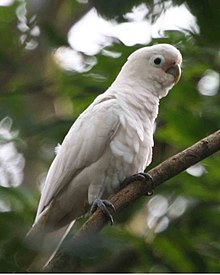Goffink's Cockatoo
| Goffink's Cockatoo | ||||||||||
|---|---|---|---|---|---|---|---|---|---|---|

Goffink's Cockatoo ( Cacatua goffiniana ) |
||||||||||
| Systematics | ||||||||||
|
||||||||||
| Scientific name | ||||||||||
| Cacatua goffiniana | ||||||||||
| ( Finsch , 1863) |
The Tanimbar Corella ( Cacatua goffiniana , Syn. : Cacatua goffini ) is a parrot of the family of Cockatoos . It was named after the ornithologist Andreas Leopold Goffin .
The Goffink's cockatoo is originally found exclusively on the Indonesian Tanimbar Islands , which form an island bridge between the Asian and Australian mainland.
description
The Goffink's cockatoo reaches a length of 32 centimeters and is thus the smallest species from the genus of the actual cockatoo next to the red-faced cockatoo and the Solomon cockatoo . The plumage is snow white. The head feathers are salmon pink at the base. The ear covers have a light yellowish tint. The underside of the wings and tail are colored yellow. The reins are pink. The sensitive beak is gray-white and well adapted to chewing hard food. The legs are gray. The males and the young have dark brown and the females red-brown eyes, which are surrounded by bare white facial skin.
Young birds are similar to adult birds. The salmon-red rein is only hinted at in them.
distribution and habitat
It is native to the islands of Yamdena and Larat, which are part of the Tanimbar Islands. It was introduced on the Indonesian Kei Islands . It inhabits forests, forest edges and cultivated areas.
Reproduction
Cockatoos in the wild can likely breed year-round. The clutch is located in a tree cavity and consists of two eggs. In captivity, the breeding season begins in May. Between two and four eggs are laid and hatched for 28 days. Often, however, sterile clutches also occur. The young can fledge after eight weeks.
food
Little is known about their diet in the wild. Occasionally it invades the corn fields and does damage. In human care, its diet consists of sunflowers , safflower , oats , wheat , buckwheat , unpeeled rice , cooked corn , fruit, vegetables, fresh branches with buds and flowers, pigeon food, and regularly vitamins and minerals.
attitude
The Goffink cockatoos can be successfully bred in captivity. For species-appropriate keeping, the aviary should have at least the dimensions 4 × 1.5 × 2 m and consist of strong wire mesh. In Austria, 3 × 2 × 2 m (length × width × height), i.e. 6 m², are required by law as the minimum size. The incubator should hang in a dark place in the aviary. Recommended dimensions for the box are 25 × 25 × 40 centimeters. During the breeding season they can be sensitive to disturbances.
At first, the adult birds are shy and reserved. After they have gained confidence, they become active and can sometimes get very loud. The ornithologist Dieter Hoppe , who specializes in parrots, describes the Goffink's cockatoo as completely unsuitable for keeping in a cage because of its great urge to move and points out that they are nocturnal on bright moonlit nights and during this time they also let out their very loud calls at night.
Goffink's cockatoos are very susceptible to the psittacin beak and feather disease (PBFD; English for "feather and beak disease of parrots"). This is a highly contagious, incurable, and often fatal viral infection that occurs in parrot birds. It is the most common viral disease in parrots in Germany and now affects not only large parrots, but also budgies and other small parrot birds.
The causative agent of the PBFD is the Beak and Feather disease virus (BFDV) from the virus genus Circovirus . These are small, 12–21 nm large, non-enveloped DNA viruses . Circoviruses are very contagious. They have a high tenacity in the environment and are only safely killed by a few disinfectants (e.g. glutaraldehyde ). The infection is done by oral uptake of the virus or an airborne droplet infection. Due to the high tenacity, indirect transmission through inanimate vectors (cage furniture, clothing, claw scissors, etc.) is also possible. The incubation period , i.e. the period from infection to actual disease, can stretch on for months or even years. Therefore, when buying animals, there is a very high risk of the disease being introduced into a bird house.
Existence and endangerment
The Goffinkakadu is listed in Appendix I of the CITES agreement and by the IUCN in the category "near threatened" (shortly before the threat). According to Birdlife International, there are an estimated between 300,000 and 400,000 specimens at risk from extensive trapping for the pet trade (up to 10,000 specimens annually in the 1980s) and forest clearing.
supporting documents
Individual evidence
- ↑ Hoppe, p. 183
- ↑ 2nd Animal Husbandry Ordinance on the homepage of the Austrian Federal Chancellery
- ↑ Appendix 2: Minimum requirements for keeping birds of the 2nd Animal Husbandry Ordinance, homepage of the Austrian Federal Chancellery
- ↑ Hoppe, p. 185
literature
- Dieter Hoppe: Kakadus - way of life, keeping and breeding , Eugen Ulmer Verlag, Stuttgart 1986, ISBN 3-8001-7155-4
Web links
- Lexicon of Parrots
- Videos, photos and sound recordings of Cacatua goffini in the Internet Bird Collection
- Cacatua goffiniana inthe IUCN 2013 Red List of Threatened Species . Listed by: BirdLife International, 2012. Retrieved December 26, 2013.
